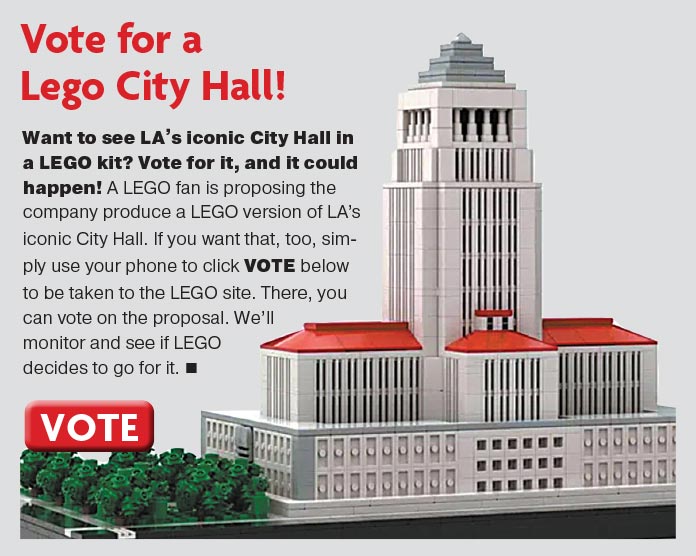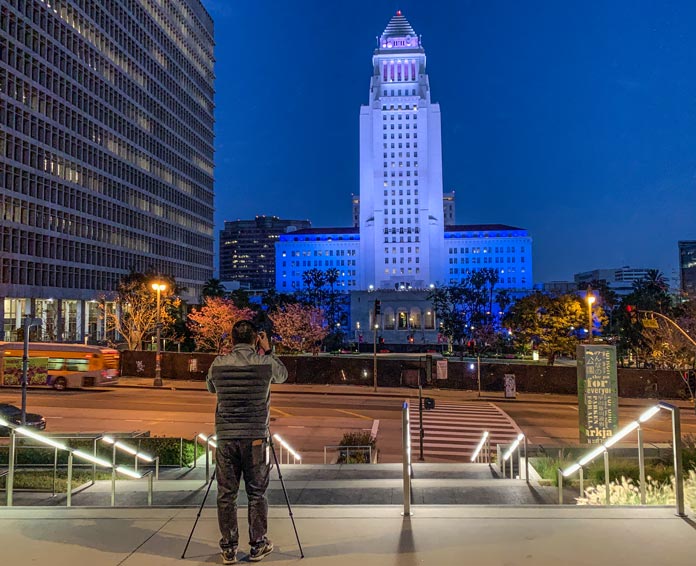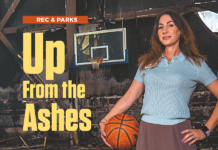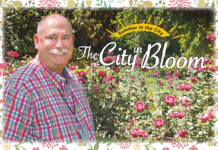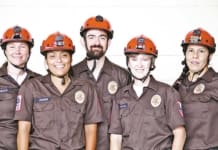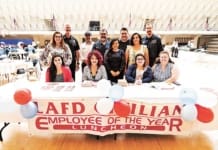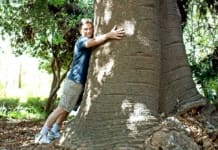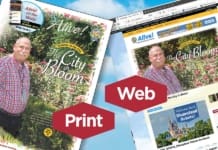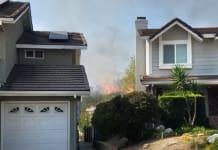
Photos by Summy Lam, Club Director of Marketing; Alive! editor John Burnes; and General Services
City Hall comes alive in a variety of colors and designs thanks to three City teams.
Have you noticed? City Hall has never looked better … or brighter.
If you’ve been downtown, or if you’ve watched the news pretty much any week, you will have seen City Hall lit very dramatically and beautifully. The LA landmark might be bathed in the colors of the U.S. flag; or colors representing Filipino, Italian, or Asian-American heritage; or colors to bring awareness to issues including the 19th amendment giving women the right to vote; or memorials for hometown heroes including Kobe Bryant or the Dodgers winning the World Series.
Your eyes are not betraying you. It is different. And beautiful. The Club certainly noticed.

The new illuminations – officially the City Hall Lighting Project – is the product of three teams at General Services – Special Services, Construction Forces, and Building Maintenance. In cooperation with the Mayor’s Office, General Services wanted to take advantage of the huge leaps in illumination technology over the past decade and improve on the colored-gel-based system that had been in place roughly since Project Restore rebuilt City Hall around 2000. Working with the Mayor and Council, General Services obtained funding to implement energy saving, state-of-the-art lighting technology at this iconic building over two years beginning in 2018. Kelly Cooper (now Retired) led the work of Construction Forces to bring this project to completion, giving the Building Maintenance crew led by India Griffin the ability to change the building’s color while also continuing to offer classic white.
Completed in 2019, the City Hall Lighting Project stands out as one of the City’s most visible upgrades. The building, wearing one of its many custom designs, is shown frequently on national TV news as it tells a story of LA pride in whatever we as a City happen to be celebrating or mourning on that day.

In this month’s feature, read about how the project came about, how it was built, what it’s capable of, how it’s a source of pride, and who gets to order that an illumination be turned on (elected officials only).
(Alive! thanks Valerie Melloff, Assistant General Manager, Melody McCormick, Acting Assistant General Manager; and Eric Robles, Director, Special Services, all at General Services and Club Members; and Peter Rogers at Forman and Associates for their valuable background information and assistance.)


Coloring the LA Sky
On April 6, Club COO Robert Larios and Alive! editor John Burnes interviewed team members who managed the City Hall lighting project and built the system. Interviewed from Special Services, Construction Forces and Building Maintenance within General Services were: Graham Harrison, Construction Project Coordinator, 24 years of City service; Club Member; Jerry Pavia, Electrical Foreman Lead, 4 years (35 years with Local 11); Brian Baltazar, Management Analyst, 4 years; Pierre Riotoc, Assistant Director, Special Services; 16 years; Eric Robles, Chief Management Analyst, Special Services, 22 years, Club Member; and Matthew Rocke, Building Maintenance District Supervisor, 15 years.
Alive!: Thanks everyone for talking to us today. First, give us a quick update on how you got to your current position. Go ahead, Matt.
Matthew Rocke: I worked as a union electrician at Disney. Came here to the City and worked as a hall hire out at the Airport. I worked on the lighting and the pylons there. That was in 2008. And then came here in 2009 and been in the Building Maintenance Division ever since.
How about you, Pierre?
Pierre Riotoc: Before the City, I worked in a couple places. I was always in manufacturing and the aerospace industry as a project manager or in that capacity. When I came to the City, I started off in the Building Emergency Education Program. I moved around a little bit to Budget and Finance and Procurement, and now I’m working with Special Services.
I guess you’ve done a lot of projects with the City.
Pierre: I’m in charge of the Filming and Building Emergency Education Program as well as Special Events. Because we’re Special Services, we also do special projects.
Pierre and Eric Robles have helped the Employees Club in the past with a Special Event, our annual meeting event at City Hall.
Pierre: Yes! We schedule or manage events in the Civic Center. We missed you last year because of COVID, when it was canceled, right?
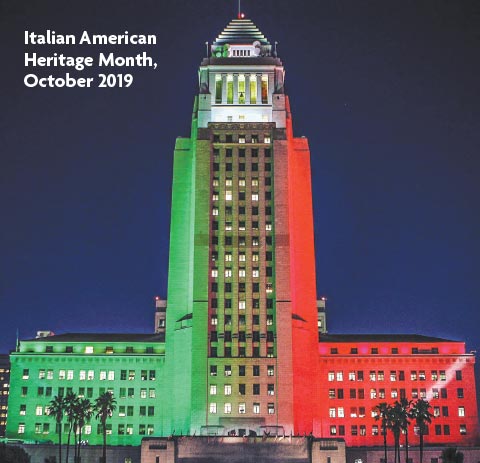 Yes.
Yes.
Pierre: Before COVID City Hall saw almost daily events there, maybe around 100 to 150 events a year in that facility. And then we would do events in the forecourt and large events like Made in America and the First Amendments demonstrations and organized rallies. I believe we did a big event for the LA Times food writer Jonathan Gold after his passing. We lit the buildings in gold for that.
Thanks! How about you, Brian?
Brian Baltazar: I graduated from Long Beach State and then basically skipped around from city to city working in Buena Park, Whittier, Anaheim and Long Beach, and now I’m in L.A. I started in 2017 and it looks like it’s going to be my long-term career move.
Thanks. Eric?
Eric Robles: Sure. Before the City I worked in law firm management, and I was a general manager of a glass-manufacturing company producing glass and AD specialty items. Just before the City, I was Executive Director of a law firm. With the City, I started with the Special Events Unit. I evolved through that operation and took on Building Emergency Education and Emergency Operations Planning, along with other units such as office management and the City conference center, mail services and the credential and access unit.
Our Special Services Division has a broad range of scope. As Pierre mentioned, we get Special Projects that don’t fit into other General Services Divisions, but kind of overlap. Most of what Special Services does is not only interface with our elected officials and other outfacing groups, but we’ll coordinate with our divisions internally as well to facilitate what’s needed or coordinate the efforts. I’ve been doing that pretty much since I was at GSD. My role has built from there. I started as a Management Assistant, then to Management Analyst, and then moved my way up to the position I have now.
Got it. Jerry?
Jerry Pavia: When I was in IBEW, Local 11, I ran two major projects in Downtown L.A. I helped build the first Interstate Tower and the Gas Company Tower. I worked at Miller Brewery and helped design the Miller Draft line. Right before coming to the City I helped build the Walking Dead attraction and the Harry Potter ride at Universal Studios. Those were my last big projects before coming to the City.
Wow. Is the City Hall lighting project the first thing you did when you joined the City? Or have you done other things?
Jerry: I was here back in 1999 when they restored City Hall for the fire alarm. And that’s where I met Graham.
Was that Project Restore?
Jerry: Yes. And I worked around in the City. I’m familiar with a lot of the locations and buildings because I spent a lot of years in Downtown L.A. working on them.
Right. And finally Graham.
Graham Harrison: I was dispatched from Local 11 in 1997 working on the City Hall East Restack, which was in preparation for the City Hall restoration. We were making room for the Councilmembers and different people who were occupying City Hall. Then in 2000 to 2005, I worked at City Hall on the restoration. That’s when I became a regular Electrician with the City. I was promoted to Senior in about 2005 and then more recently to Electrician Supervisor around 2015. And since then, our division has had me construction managing some of the more complex electrical jobs, including the P4 ITA server room, the Data Center ATSAC and of course the LED lighting at City Hall.
 Increasingly Lit
Increasingly Lit
Now let’s talk about the City Hall lighting project. What were the efforts in the past? Not just the general building lighting for safety, but the big-scope feature lighting that we have now.
Eric: I started, right when the building was reopening after restoration. Going back to that time, we would get a few requests to try to light City Hall, and the majority of the time it meant having to bring in actual light rigging to overlap with existing lights. It was like a theatrical uplighting of colors. That was mostly because the heat on the existing lights did not allow for the colored gels. At the time the gels couldn’t handle the high-intensity heat that came off of the lights. But that evolved into having the capability of using gels, and we would be asked to place gels on top of existing lights to color the building.
Matthew: Basically from the building maintenance perspective, Eric or Pierre would give us a request to light the building. We knew it was coming but it always seemed to come at the last moment. We’d have a vendor come out, they’d bring hundreds of lights and they’d stretch extension cords; they’d have extensive safety issues to deal with. They had to lean off the side of the building. And then they’d get the colors out and they didn’t always hit the mark on the color.
Eric: They got as close as they could, but it wasn’t exact. It was always a challenge to match, or approximate, a color.
Matthew: We had a lot of man-hours setting it up, and the teardown would be another day. In between you’d have issues with, maybe somebody tripped over a cord or a breaker tripped or something like that.
Graham: I was really glad Peter Rogers from our contractor Forman and Associates was able to fill in some of this. Peter wrote that City Hall building in 1928 was the lone exception to the City’s rule that no building should be higher than 150 feet. That held until the 1960s, making it the tallest in the region for nearly 40 years and visible from larger parts of the City.
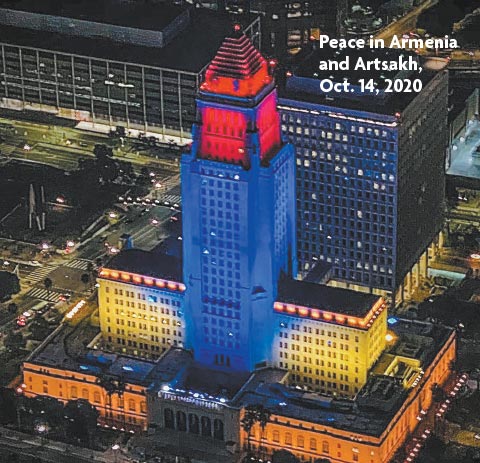 Over the many years, many lighting technologies were used to illuminate the building’s exterior and seasonally for special events, and the flood lighting was colored using theatrical colored lights like Eric said. Yeah, this was time consuming, etc. In 2014, the City began the project to explore new ways of lighting the building to save energy and to give the building a dramatic new look with the ability to change color while continuing to also offer the classic white light for the building.
Over the many years, many lighting technologies were used to illuminate the building’s exterior and seasonally for special events, and the flood lighting was colored using theatrical colored lights like Eric said. Yeah, this was time consuming, etc. In 2014, the City began the project to explore new ways of lighting the building to save energy and to give the building a dramatic new look with the ability to change color while continuing to also offer the classic white light for the building.
Matthew: For most of those years the only thing that stood out as far as lighting was the Lindbergh light. That was the only thing that was notable.
Eric: The Lindbergh Beacon on top of City Hall. It was lit every once in a while as well. It was reinstalled during Project Restore.
Graham: During Project Restore we had a helicopter set it from above.
Whose idea was it to go to the next step back in 2014? Was it an ongoing maintenance kind of a question, or more than that?
Eric: It was more of a collaboration and a team of everybody involved that knew that it needed to be done, and could be done with existing technology. Each division had a perspective of being able to see the progression of that light system from the efficiency that Graham mentioned to the requests that come through the Special Events or the Facilities to do things. It was more of a collaboration of everybody seeing the need and moving it forward.
Graham: Michael Samulon from the Mayor’s Office was one of our main contributors around meetings and attended all our construction meetings. He really pushed the project and assisted with getting additional funding as we needed it.
The Mayor’s Office was certainly monitoring the progress of this project.
Graham: They were very interested, yes.
 A Modern System
A Modern System
Give us an overview of the system as it exists now.
Graham: Sure. The project was done in phases, the first phase being the west side, the Spring Street side. We started the project in February 2019, and the deadline was to have the project, at least the west side of the building, done for the Gay Pride event which was I think the 1st of June.
A quick deadline for permanently installed lights.
Graham: Yes, just for the west side at that point. We had to figure out all our conduit runs, and we were trying to utilize the existing runs as much as we could. We also had to maintain the lighting to the rest of the building. We didn’t want the building to go dark during the construction phase. We also had to run a lot of additional data conduits. The lights are controlled from a controller, but the controls weren’t over the City network and there were a number of what are called data enablers that control specific banks of lighting.
Right.
Graham: So we had to find our routes for all the conduits to the data enablers so we could pull all the low-voltage controls to the data enablers and then add all the circuits that were needed to power up the new lights while keeping the existing lights going on the other sides of the building.
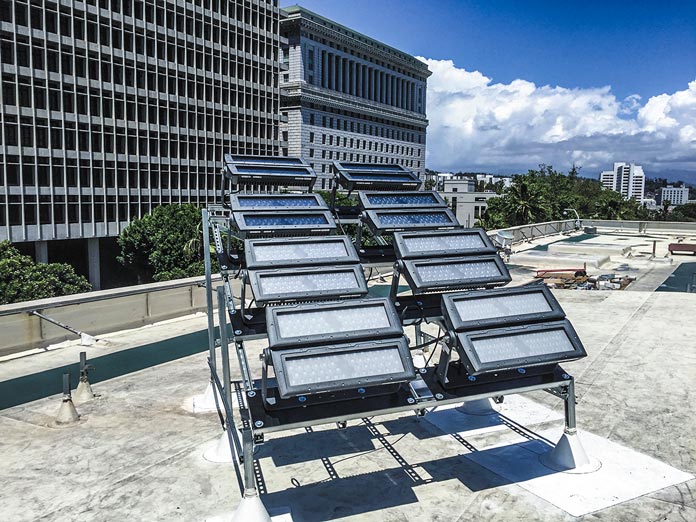
Yes. You can change the color. You don’t have to put new gels in or anything like that.
Graham: Correct.
According to Peter again, the first five floors were lit with color-controllable lights chosen for both performance and efficiency, to help the building meet the California Energy Code requirements of Title 24. One-hundred-sixty of the luminaires are mounted on the street level on the three sides of the building. The bulk of the building is illuminated with luminaires mounted on the fifth floor roof. Additional luminaires are mounted on the 10th, 12th and the 25th floors to reach the areas that couldn’t be reached from the fifth-floor roof. The 10th floor features linear fixtures to provide highlights, and the inset that begins on the 25th floor uses color-reach fixtures on all four sides. And the 26th floor observation deck is lit with compact color reaches. The top of the building is illuminated from the parapet, roughly what would be the 35th-floor-level of the building.
The controls form an integral part of the system with the building calendar and scheduler that automatically starts the day’s event at sunset and turns off the system at sunrise. The system dims by 40 percent at 2 a.m. to save energy and still provide consistent appearance. the design assumes the building to be white unless a specific request is made for any given day or time. And to simplify programming further, a set of prebuilt settings was created with team colors from all the major local sports teams, the flags of more than 50 countries, most major holidays, seasonal events from the Fourth of July to Breast Cancer Awareness. The Pharos lighting control features are a custom user interface that allows users to select pre-programmed events or create a unique look for the building using point and click technology to apply them to different parts of the building.
So all the lights are attached to the building. You don’t have luminaries on any other buildings like City Hall East projecting on City Hall from a block or two away. Everything is uplit form the building itself.
Graham: That’s right.
Who designs the look? Who designs the lighting settings?
Graham: The Pharos lighting controller was preprogrammed with a lot of presets. But Matt Rocke and his team can design a custom show if it were requested. Most of the shows are preprogrammed already in the system.
Matthew: Yeah, there have been a couple custom designs. Cory McGee is the Electrical Supervisor, and he receives most of those requests from Pierre and Eric. They give him a general idea of what they want and he’ll give them a rendering. He can give them a rendering of what the building would look like in a couple of minutes. He sends it over to whomever wants to see it. They approve it. And then they send it back to Cory and then he inputs the instructions.
Does Cory have a remote capability? Can he walk a couple blocks away with a laptop or a tablet and and adjust it on the fly?
Matthew: Yes, he can. He’s done that quite a few times. He’s made minor adjustments.
It’s important to mention that they’re LEDs. They’re not gels at all. And there’s a combination of four lights in each luminaire. One is white, and the others are the primary colors. They adjust the level of each one of those colors to derive whatever color is requested.
I saw a photo that showed a big Batman logo projected on City Hall. Is the system capable of projecting specific graphics?
Eric: No. That was not done by lighting. That’s something different. That’s projected by what is called a gobo. It’s not part of the infrastructure that we have. That was brought in from the outside.
Graham: There is discussion about adding some gobos to project those images. I think we were talking about putting three of them in, but so far we haven’t got any funding for them. We discussed it two years ago. But that was before the City hit a $700 million deficit because of the pandemic.
 Usage
Usage
How many nights a week is it lit up, other than just the basic white? For special messaging.
Pierre: It depends on what the elected officials want to light. It doesn’t happen as often as you’d think. Maybe 10 to 20 times a year. The duration is typically the day of the event, which is one day, to a week.
What’s the process for submitting a request?
Eric: Effectively, it comes from the elected officials to the Special Events Unit to start the process, and then information is passed along as far as the types of color as far as down to Building Maintenance. And the Council usually will get a motion for the lighting as well. How they facilitate it from their end is internal to them. We do not take requests from anyone other than elected officials.
Graham: Otherwise, you’d get everyone’s birthday.
Pierre: Yes. All the lighting requests come from an elected official. Either the Mayor’s Office or the City Council would be the ones asking for the lighting.
 Got it. Have you ever run into conflicts where two people want something on the same night?
Got it. Have you ever run into conflicts where two people want something on the same night?
Pierre: More than you think, yes. That does happen. That just happened recently for the transgender lighting and Greek Independence. That was one of the conflicts of planning.
Like everything else in life, you just work it out.
What were the special challenges to implementing the current system?
Graham: As always, working in an occupied building is always challenging. You’re always going to upset somebody once you start a rotary hammer drilling in the concrete. But finding routes through our conduits… throughout the, you know, the finished portions of the building are challenging and then coordinating between Council meetings, Public Works meetings and different offices’ schedules. Installing the luminaires at the top of the building was challenging. We were hanging off the parapet.
Jerry: Four hundred feet up.
Graham: We had to set up fall protection. That was set up by a specialist company. It’s a little hairy out there if you’re not used to heights. I’m not used to heights.
 Favorite Designs
Favorite Designs
What’s been your favorite design so far?
Graham: I like the designs that have less color than more color, color blocks rather than wild colors. They’re more vivid when you have a whole block, say, like, red, white and blue or even a solid color, like Dodger blue. Sometimes you see City Hall in the background when they pan over from Dodger Stadium. City Hall’s always in the background when they’re interviewing people at Dodger Stadium. That’s more impressive, in my opinion.
Jerry: The one that stands out is the Filipino Day because they had a sun on the flag, and they actually made it shimmer at the very top of the Tower if you pay attention. That was real cool. That caught my attention. I was there at night adjusting the lights, and you could see it flickered to simulate that sun or the star on the flag.
Matthew: I’m old school. I like the original color. Graham and Cory did such a good job in making sure that we sustained that original color that we don’t get complaint calls. It stayed the same, and that’s my favorite.
Eric: There have been so many dramatic lightings. I like the solids, the greens and the teals. I think the one that was just up for Greece with the trim was well done as well. We’ve had some that are really sharp and vivid. I have a picture on my phone with the green one.
Pierre: Probably the bold colors -0 blue or maybe even gold, where it’s more eye popping.
Brian: I have to say the tri-color ones are the best. Like Jerry said, the Philippine flag or the Mexico flag for El Grito. But I have an affinity for the Laker colors, so purple and gold.
 Pride on Display
Pride on Display
Are you proud of what you’ve accomplished? When you look at the work that goes up at night, can you say to yourself, “Hey, I helped do that?”
Eric: It’s a great thing to be a part of.
Matthew: I’m proud to say that Construction Forces and Building Maintenance did this project. This didn’t involve an outside contractor. This was done with all City forces, and it’s operated by City forces. Whereas before, we had an outside contractor that really wasn’t vested in the project. They came out, did their job and left. The thing we should all be proud of is that we had people like Cory and Graham and everybody at Construction Forces doing the job. That’s the biggest thing for me.
Pierre: I want to echo what Matt said. It’s all done in-house. All the design is all done in-house. In the past we had to coordinate with vendors. This is a City project.
Graham: We take pride in our work. Here at Construction Forces we like to walk away from a project knowing that we’ve done a class-A job. We were proud to be a part of it. Everyone in the City and around the world sees this iconic building lit, and we’re very proud to have been part of it.
Jerry: It’s now part of the history of Los Angeles. It’s a generational thing because I tell my kids, I tell my grandkids, “I helped build that.” And they’ll talk about it forever.
What do you love about what you do?
Graham: These projects are very challenging. We’re given a set of plans. We have no idea at first how we’re going to address it, but we break it down and we work with various entities. It’s very satisfying to be part of a process where you’re starting out from nothing and building something.
Jerry: And same thing for me. It’s a bunch of lines on a paper and it looks nice. But then you get into it and you start dissecting it. At the end, you’re like, “Wow. We did this.”
Graham: With all its challenges.
Pierre: Everybody can enjoy seeing this project throughout the City. And it’s for the public to enjoy. When there is an event and the building’s lit, it helps them enjoy it.
Thanks for the interview, gentlemen!
Eric: Thank you.
|
BEHIND THE SCENES
Club Director of Marketing Summy Lam photographs City Hall, which was lit to celebrate Israeli Independence Day, April 14. |



